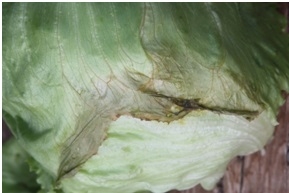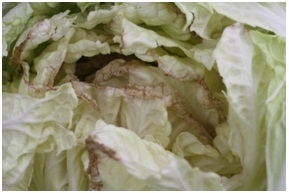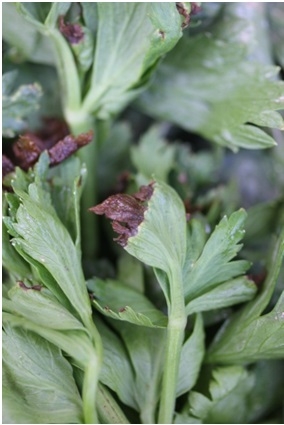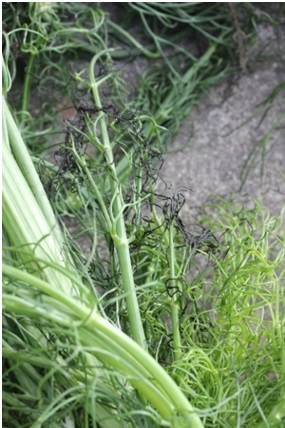In the summer of 2014 we received an unprecedented number of plant samples with calcium disorders from growers and PCA's. Normally we expect to see a spike in tipburn samples in July into August on romaine, but this year we had samples from a wide variety of crops and the calcium related issues persisted into October. The most well known calcium disorder in our area is tipburn on head and romaine lettuce.
Calcium disorders are not generally related to low levels of calcium in the soil solution. In a study conducted in the Salinas Valley in 2006 with Tim Hartz, we observed that soil solution calcium ranged from 5 - 80 meq/liter and averaged 34 meq/liter. Each meq/liter = 20 PPM, therefore soil solution calcium ranged from 100 - 1,600 PPM. By comparison, hydroponic nutrient solutions used in greenhouse vegetable production typically contain only 150-250 PPM Ca. Calcium deficiency on vegetables is more of a physiological issue related to the affected tissue obtaining sufficient calcium from the flow in the xylem of the plant. The flow of xylem in the plant is driven by transpiration. If not enough water is moving through the plant, temporary and localized calcium deficiency may occur.
In crops like head lettuce, cabbage and nappa cabbage it is easy to envision low levels of transpiration may occur on leave on the inside of the head once the wrapper leave close in. In head lettuce a great deal of effort has taken place to select and breed for tipburn resistant varieties. In general, tipburn resistant varieties have worked well in head lettuce, but this year we observed greater incidence of tipburn on head lettuce (photo 1). Significant tipburn was also observed in both cabbage and nappa cabbage (photos 2&3).
Another crop that had significant calcium disorders was celery (photo 4). In celery it is called black heart and this year many fields were affected. Fennel is in the same plant family as celery and for the first time this year we had samples with black heart symptoms (photo 5). Other crops that were affected with calcium disorders included broccoli (brown bead), cauliflower and artichokes.
In the 2006 study we identified low evaporation due to fog as the main factor that increased the incidence of tipburn on romaine lettuce during the months of July and August. There has been less breeding for tipburn resistance in romaine and this crop is fairly susceptible to this calcium disorder. As a result growers do not plant romaine in the foggiest parts of the Salinas Valley for July harvests.
Rapid growth with low levels of transpiration is the main factor that drives calcium disorders in lettuce as well as other crops. One factor that people noted this year were the warm night time temperatures. Table 1 confirms that the minimum nighttime temperatures were higher in 2014 than in 2013 in July, August and September. We suspect that the higher nighttime temperatures allowed the crops to continue to grow rapidly in the night when there is no transpiration. Rapid growth that outstrips the crops ability to supply adequate levels of calcium to susceptible tissue is the main reason for calcium disorders in crops. Factors that induce rapid growth vary but include high soil moisture after a dry period, high levels of fertilization and high humidity. All of these factors can contribute to calcium disorders in crops. Keeping the growth rate of the crops as constant as possible may be a partial solution to this problem, but it is easier said than done, especially when there are periodic fluctuations in temperature and levels of humidity due to fog. This year it appears that the warm nights may have contributed to the issue and there was not much we could do about that.
Table 1. Monthly average maximum and minimum (nighttime) temperatures (°F) comparison between 2013 and 2014 (data from the North Salinas CIMIS station)
| Month |
Maximum Air Temp |
Minimum Air Temp |
Difference (night - day) |
Average Air Temp |
| June 2013 | 65.4 | 51.4 | 14.0 | 58.0 |
| June 2014 | 64.9 | 51.1 | 13.8 | 57.0 |
| July 2013 | 65.1 | 53.8 | 11.3 | 57.9 |
| July 2014 | 67.9 | 55.8 | 12.1 | 61.0 |
| August 2013 | 68.3 | 53.6 | 14.7 | 59.4 |
| August 2014 | 68.9 | 58.0 | 10.9 | 62.1 |
| September 2013 | 68.5 | 47.2 | 21.4 | 57.1 |
| September 2014 | 69.2 | 56.6 | 12.6 | 62.1 |




